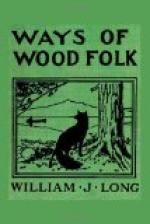One thing about the nests has always puzzled me. The soft lining has generally more or less rabbit fur. Sometimes, indeed, there is nothing else, and a softer nest one could not wish to see. But where does he get it? He would not, I am sure, pull it out of Br’er Rabbit, as the crow sometimes pulls wool from the sheep’s backs. Are his eyes bright enough to find it hair by hair where the wind has blown it, down among the leaves? If so, it must be slow work; but Chickadee is very patient. Sometimes in spring you may surprise him on the ground, where he never goes for food; but at such times he is always shy, and flits up among the birch twigs, and twitters, and goes through an astonishing gymnastic performance, as if to distract your attention from his former unusual one. That is only because you are near his nest. If he has a bit of rabbit fur in his bill meanwhile, your eyes are not sharp enough to see it.
Once after such a performance I pretended to go away; but I only hid in a pine thicket. Chickadee listened awhile, then hopped down to the ground, picked up something that I could not see, and flew away. I have no doubt it was the lining for his nest near by. He had dropped it when I surprised him, so that I should not suspect him of nest-building.
Such a bright, helpful little fellow should have never an enemy in the world; and I think he has to contend against fewer than most birds. The shrike is his worst enemy, the swift swoop of his cruel beak being always fatal in a flock of chickadees. Fortunately the shrike is rare with us; one seldom finds his nest, with poor Chickadee impaled on a sharp thorn near by, surrounded by a varied lot of ugly beetles. I suspect the owls sometimes hunt him at night; but he sleeps in the thick pine shrubs, close up against a branch, with the pine needles all about him, making it very dark; and what with the darkness, and the needles to stick in his eyes, the owl generally gives up the search and hunts in more open woods.
Sometimes the hawks try to catch him, but it takes a very quick and a very small pair of wings to follow Chickadee. Once I was watching him hanging head down from an oak twig to which the dead leaves were clinging; for it was winter. Suddenly there was a rush of air, a flash of mottled wings and fierce yellow eyes and cruel claws. Chickadee whisked out of sight under a leaf. The hawk passed on, brushing his pinions. A brown feather floated down among the oak leaves. Then Chickadee was hanging head down, just where he was before. “Tsic a dee? Didn’t I fool him!” he seemed to say. He had just gone round his twig, and under a leaf, and back again; and the danger was over. When a hawk misses like that he never strikes again.
Boys generally have a kind of sympathetic liking for Chickadee. They may be cruel or thoughtless to other birds, but seldom so to him. He seems somehow like themselves.




